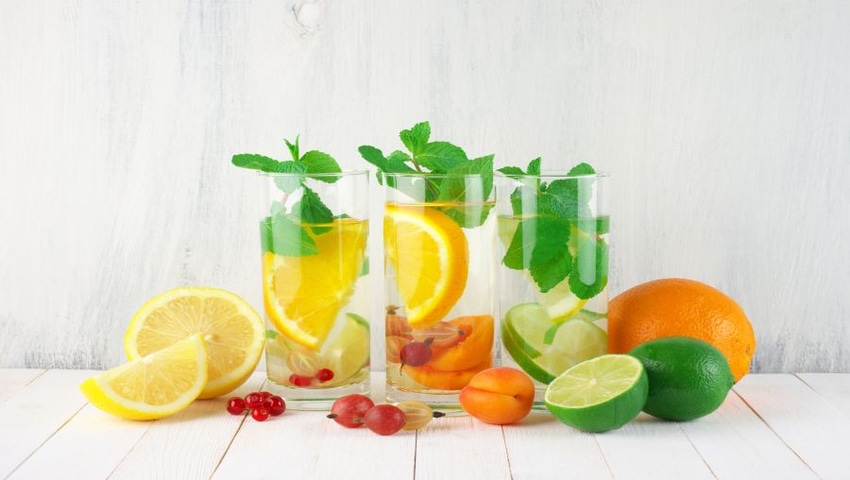Natural Flavor in Clear Beverages
Flavor is complicated, especially in beverages in the natural space where solubility challenges in ingredients is a significant opponent.

Flavor is complicated, especially in beverages. Imagine a symphony of senses bringing together taste, smell, touch and sight to complete an experience. Flavor is important as well. Yet, despite being mastered in the space of conventional beverages, using mostly synthetic ingredients, the game has become increasingly more difficult as products are maturing into the natural space where solubility challenges in ingredients becomes a more significant opponent.
Solubility Impacts Flavor
Most people subscribe to the adage that “What we taste derives mostly from our smell." The consensus is that anywhere between 75 to 95 percent of flavor is through the sense of smell (Crit Rev Food Sci Nutr. 1993;33(1):63-82). But few realize that both our taste and smell are greatly influenced by the way products look and feel, and that is where solubility has its greatest impact. In fact, the tactile sensations in the mouth and the visual appearance of a product cannot be separated from the taste experience (Physiol Behav. 2012 Nov 5;107(4):540-52).
Many consumers are unaware that even before consuming a product, they are visually judging the appearance, and instantaneously drawing upon past experiences to stage flavor expectations. So, when a beverage is a certain color, appears to be a certain thickness or clarity, contains sediment, cloudiness, etc., consumers are positively or negatively going to taste what these experiences have demonstrated in the past.
The tactile experience of flavor is just as important as sight. Texture will release certain compounds, called aroma volatiles that can change the smell and alter the way a flavor is perceived (Physiol Behav. 2012 Nov 5;107(4):484-7). Certain textures turn a consumer off completely.
Think about how polarizing pulp in orange juice is alone. Most consumers prefer no pulp, and yet this is in a fruit juice that intrinsically bears an understanding that it will contain at least some texture and sediment. Now think about products like a naturally flavored sparkling water, or an organic ginger ale. These beverages need to be clean and clear. Therefore, there is little tolerance from consumers for any type of residual sediments.
A Solution: Extracts vs. Concentrates
While taste and smell tend to exist inherently in many natural ingredients, the same cannot be said for their fundamental ability to dissolve into solution. Some formulators try to circumvent this issue using concentrates and others with extracts.
A flavor concentrate is made from removing water or other diluting agents from the original flavor material, typically concentrating to achieve or target a specific brix.
“The biggest advantage to concentrates is that they most closely resemble that which can be derived from naturally brewing or boiling the original source, for example a tea concentrate," said Chris Fields, vice president of scientific affairs at Applied Food Sciences. “However, not all concentrates are created equal given the variability in the raw material. Even the same source of materials can yield different strengths and quality of flavors. So, consistency from batch to batch requires formulators to take the extra time to match their flavor profiles. Another limiting factor is that concentrates can also retain less desirable compounds impacting viscosity, taste and nutritional content of the finished product."
A flavor extract is prepared by chemical extraction and/or evaporation to separate the active flavor or other health compounds from the original material. There are two types of extraction methods. One is a standardized nutraceutical extraction, and the other is a flavor specific extraction.
“Standardized extracts from a plant source can isolate just the active compounds desired for the end formulation, streamlining your ingredient selection," Fields explained. “By using a well-developed extract that is fully water soluble and clear in solution, formulators can achieve optimum and consistent sensory profiles on the finished products with more accurate levels of functional attributes."
Outside of standardized nutraceutical extracts, a different extraction processes can pull out the true flavor and essences from the raw material, according to Grace Venus, president of Venus Research and Development Inc. “This process is typically a vapor distilled extraction where aroma and flavor is concentrated and is best made from botanical and citrus ingredients as they have a large concentration of essential oils," she said. “This is the type of extract that would be used as a flavor top note and are very important to the overall perception of flavor depth in many beverages on the market."
Attend Beverage Marketplace on April 20 as part of Ingredient Marketplace in Orlando to learn more about how to incorporate unique, healthy ingredients into a beverage matrix, as well as go-to-market strategies, including identifying the right target market and navigating macro trends. ADM is the premier underwriter of Beverages Marketplace.
Brian Zapp, director of marketing at Applied Food Sciences Inc. (AFS), has a diverse background in business and marketing including work with nonprofits, development in club sports and assisting as an advisory roles to many beverage startups.
About the Author(s)
You May Also Like






.png?width=800&auto=webp&quality=80&disable=upscale)